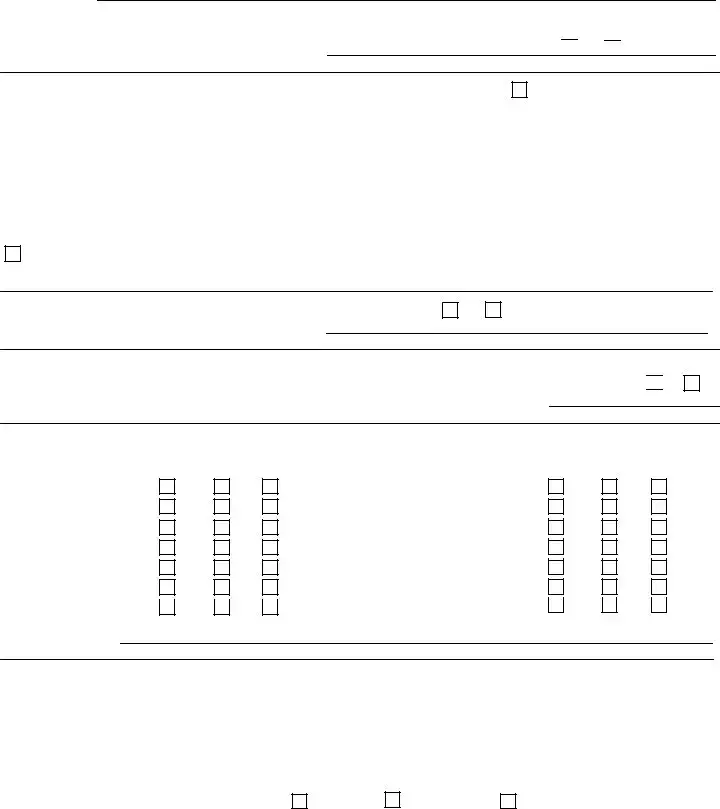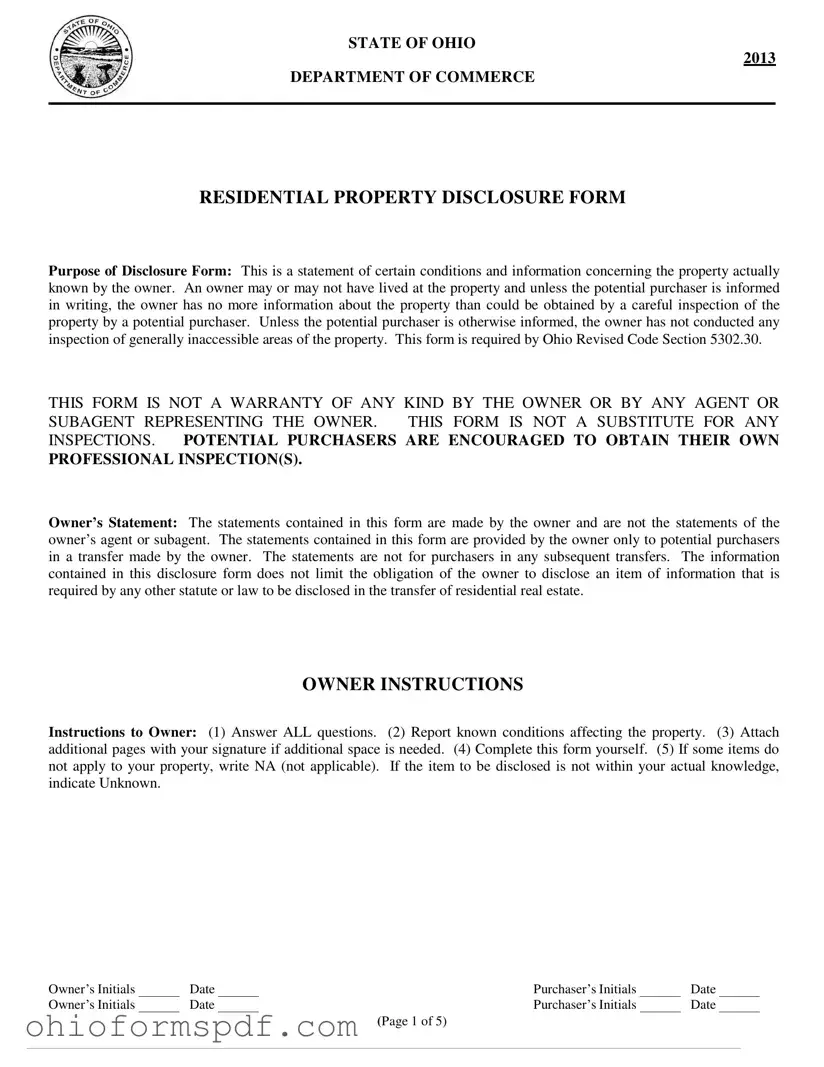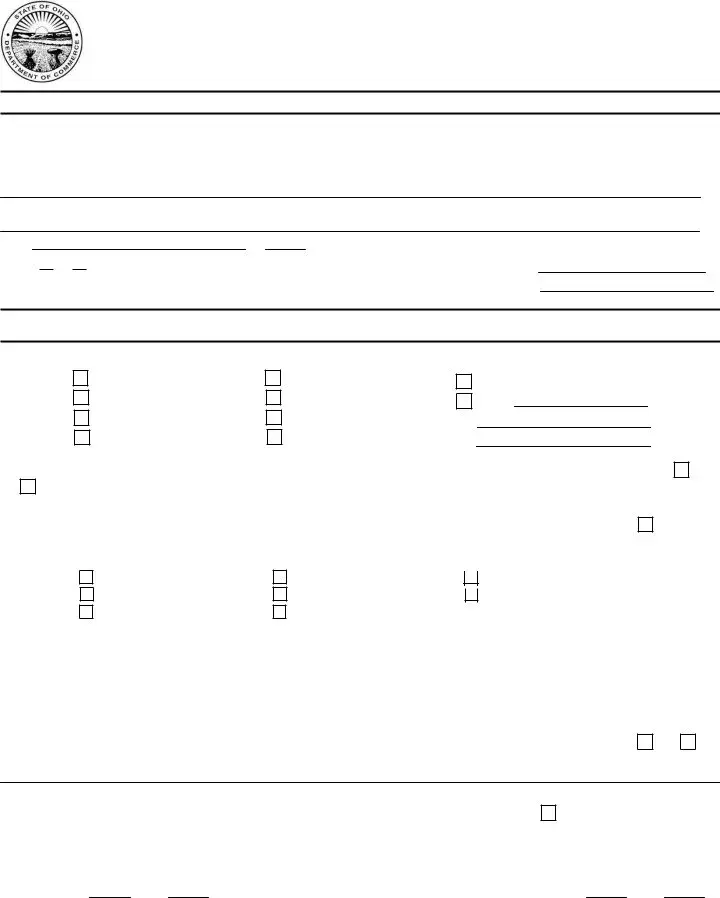STATE OF OHIO
2013
DEPARTMENT OF COMMERCE
RESIDENTIAL PROPERTY DISCLOSURE FORM
Purpose of Disclosure Form: This is a statement of certain conditions and information concerning the property actually known by the owner. An owner may or may not have lived at the property and unless the potential purchaser is informed in writing, the owner has no more information about the property than could be obtained by a careful inspection of the property by a potential purchaser. Unless the potential purchaser is otherwise informed, the owner has not conducted any inspection of generally inaccessible areas of the property. This form is required by Ohio Revised Code Section 5302.30.
THIS FORM IS NOT A WARRANTY OF ANY KIND BY THE OWNER OR BY ANY AGENT OR
SUBAGENT REPRESENTING THE OWNER. THIS FORM IS NOT A SUBSTITUTE FOR ANY
INSPECTIONS. POTENTIAL PURCHASERS ARE ENCOURAGED TO OBTAIN THEIR OWN
PROFESSIONAL INSPECTION(S).
Owner’s Statement: The statements contained in this form are made by the owner and are not the statements of the owner’s agent or subagent. The statements contained in this form are provided by the owner only to potential purchasers in a transfer made by the owner. The statements are not for purchasers in any subsequent transfers. The information contained in this disclosure form does not limit the obligation of the owner to disclose an item of information that is required by any other statute or law to be disclosed in the transfer of residential real estate.
OWNER INSTRUCTIONS
Instructions to Owner: (1) Answer ALL questions. (2) Report known conditions affecting the property. (3) Attach additional pages with your signature if additional space is needed. (4) Complete this form yourself. (5) If some items do not apply to your property, write NA (not applicable). If the item to be disclosed is not within your actual knowledge, indicate Unknown.
Owner’s Initials |
|
Date |
|
Purchaser’s Initials |
|
Date |
Owner’s Initials |
|
Date |
|
Purchaser’s Initials |
|
Date |
|
|
|
|
|
|
(Page 1 of 5) |
|
|
2013
STATE OF OHIO DEPARTMENT
OF COMMERCE
RESIDENTIAL PROPERTY DISCLOSURE FORM
Pursuant to section 5302.30 of the Revised Code and rule 1301:5-6-10 of the Administrative Code.
TO BE COMPLETED BY OWNER (PLEASE PRINT)
Property Address:
Owners Name(s):
Date:, 20
Owner  is
is 
 is not occupying the property. If owner is occupying the property, since what date:
is not occupying the property. If owner is occupying the property, since what date:
If owner is not occupying the property, since what date:
THE FOLLOWING STATEMENTS OF THE OWNER ARE BASED ON OWNER’S ACTUAL KNOWLEDGE
A) WATER SUPPLY: The source of water supply to the property is (check appropriate boxes):
Public Water Service
Private Water Service
Private Well
Shared Well
Holding Tank
Cistern
Spring
Pond
Do you know of any current leaks, backups or other material problems with the water supply system or quality of the water? |
|
Yes |
No |
If “Yes”, please describe and indicate any repairs completed (but not longer than the past 5 years): |
|
|
|
|
|
|
|
|
|
|
|
Is the quantity of water sufficient for your household use? (NOTE: water usage will vary from household to household) |
Yes |
|
No |
|
B)SEWER SYSTEM: The nature of the sanitary sewer system servicing the property is (check appropriate boxes):
|
|
|
|
|
|
Public Sewer |
Private Sewer |
Septic Tank |
Leach Field |
Aeration Tank |
Filtration Bed |
Unknown |
Other |
|
|
|
If not a public or private sewer, date of last inspection: |
|
Inspected By: |
|
Do you know of any previous or current leaks, backups or other material problems with the sewer system servicing the property?
Yes |
|
No |
|
If “Yes”, please describe and indicate any repairs completed (but not longer than the past 5 years):_ |
|
|
|
|
|
|
|
Information on the operation and maintenance of the type of sewage system serving the property is available from the
department of health or the board of health of the health district in which the property is located. |
|
|
C) ROOF: Do you know of any previous or current leaks or other material problems with the roof or rain gutters? |
Yes |
No |
If “Yes”, please describe and indicate any repairs completed (but not longer than the past 5 years): |
|
|
|
D)WATER INTRUSION: Do you know of any previous or current water leakage, water accumulation, excess moisture or other
defects to the property, including but not limited to any area below grade, basement or crawl space? |
Yes |
|
No |
If “Yes”, please describe and indicate any repairs completed: |
|
|
|
|
|
|
|
|
|
|
|
|
|
|
|
|
|
|
|
Owner’s Initials |
|
Date |
Purchaser’s Initials |
|
|
Date |
Owner’s Initials |
|
Date |
|
|
Purchaser’s Initials |
|
|
Date |
|
|
(Page 2 of 5)

Property Address_
Do you know of any water or moisture related damage to floors, walls or ceilings as a result of flooding; moisture seepage; moisture condensation; ice damming; sewer overflow/backup; or leaking pipes, plumbing fixtures, or appliances? 
 Yes
Yes 
 No
No
If “Yes”, please describe and indicate any repairs completed:
Have you ever had the property inspected for mold by a qualified inspector? |
Yes |
|
No |
|
If “Yes”, please describe and indicate whether you have an inspection report and any remediation undertaken: |
|
|
|
|
|
|
|
Purchaser is advised that every home contains mold. Some people are more sensitive to mold than others. If concerned about this issue, purchaser is encouraged to have a mold inspection done by a qualified inspector.
E)STRUCTURAL COMPONENTS (FOUNDATION, BASEMENT/CRAWL SPACE, FLOORS, INTERIOR AND EXTERIOR WALLS): Do you know of any previous or current movement, shifting, deterioration, material cracks/settling (other than visible minor cracks or blemishes) or other material problems with the foundation, basement/crawl space, floors, or interior/exterior walls?
|
|
|
|
|
|
Yes |
|
No |
If “Yes”, please describe and indicate any repairs, alterations or modifications to control the cause or effect of any |
problem |
identified (but not longer than the past 5 years): |
|
|
Do you know of any previous or current fire or smoke damage to the property? |
Yes |
If “Yes”, please describe and indicate any repairs completed: |
|
F) WOOD DESTROYING INSECTS/TERMITES: Do you know of any previous/current presence of any wood destroying insects/termites in or on the property or any existing damage to the property caused by wood destroying insects/termites? 
 Yes If “Yes”, please describe and indicate any inspection or treatment (but not longer than the past 5 years):
Yes If “Yes”, please describe and indicate any inspection or treatment (but not longer than the past 5 years):
G)MECHANICAL SYSTEMS: Do you know of any previous or current problems or defects with the following existing mechanical systems? If your property does not have the mechanical system, mark N/A (Not Applicable).
|
YES |
NO |
N/A |
|
YES |
NO |
N/A |
1) |
Electrical |
|
|
|
|
8) |
Water softener |
|
|
|
|
|
|
2) |
Plumbing (pipes) |
|
|
|
|
|
a. Is water softener leased? |
|
|
|
|
|
|
3) |
Central heating |
|
|
|
|
9) |
Security System |
|
|
|
|
|
|
4) |
Central Air conditioning |
|
|
|
|
|
a. Is security system leased? |
|
|
|
|
|
|
5) |
Sump pump |
|
|
|
|
10) |
Central vacuum |
|
|
|
|
|
|
6) |
Fireplace/chimney |
|
|
|
|
11) |
Built in appliances |
|
|
|
|
|
|
7) |
Lawn sprinkler |
|
|
|
|
|
|
12) |
Other mechanical systems |
|
|
|
|
|
|
|
|
|
|
|
|
|
|
|
|
|
|
|
|
|
|
|
|
|
|
|
|
|
|
|
|
If the answer to any of the above questions is “Yes”, please describe and indicate any repairs to the mechanical system (but not longer than the past 5 years):
H)PRESENCE OF HAZARDOUS MATERIALS: Do you know of the previous or current presence of any of the below identified hazardous materials on the property?
1) |
Lead-Based Paint |
|
|
|
|
|
Yes |
|
No |
Unknown |
|
|
|
|
|
|
|
|
|
|
|
|
|
|
|
|
|
|
|
|
|
|
|
|
2) |
Asbestos |
|
|
|
|
|
|
|
|
|
|
|
|
|
|
|
|
|
|
|
3) |
Urea-Formaldehyde Foam Insulation |
|
|
|
|
|
|
|
|
|
|
|
|
|
4) |
Radon Gas |
|
|
|
|
|
|
|
|
|
|
|
|
|
|
|
|
|
|
|
|
a. If “Yes”, indicate level of gas if known |
|
|
|
|
|
|
|
|
|
|
|
|
|
5) |
Other toxic or hazardous substances |
|
|
|
|
|
|
|
|
|
|
|
|
|
|
If the answer to any of the above questions is “Yes”, please describe and |
|
|
indicate any repairs, remediation or mitigation to the |
property: |
|
|
|
|
|
|
|
|
|
|
|
|
|
|
|
|
|
|
|
|
|
|
|
|
|
|
|
|
|
|
|
|
|
|
|
|
|
|
|
|
|
|
Owner’s Initials |
Date |
|
|
|
Purchaser’s Initials |
|
Date |
Owner’s Initials |
|
Date |
|
|
|
|
|
|
(Page 3 of 5) |
Purchaser’s Initials |
|
Date |
|
|
|
|
|
|
|
|
|
|
|
|
|
|
|
|
|
|
|
|
|
|
|
Property Address_
I)UNDERGROUND STORAGE TANKS/WELLS: Do you know of any underground storage tanks (existing or removed), oil or
natural gas wells (plugged or unplugged), or abandoned water wells on the property? |
|
Yes |
No |
If “Yes”, please describe: |
|
|
|
|
Do you know of any oil, gas, or other mineral right leases on the property?  Yes
Yes 
 No
No
Purchaser should exercise whatever due diligence purchaser deems necessary with respect to oil, gas, and other mineral rights. Information may be obtained from records contained within the recorder’s office in the county where the property is located.
J) FLOOD PLAIN/LAKE ERIE COASTAL EROSION AREA: |
Yes |
No |
Unknown |
Is the property located in a designated flood plain? |
|
|
|
|
|
|
|
Is the property or any portion of the property included in a Lake Erie Coastal Erosion Area? |
|
|
|
|
|
|
|
K)DRAINAGE/EROSION: Do you know of any previous or current flooding, drainage, settling or grading or erosion problems
affecting the property?  Yes
Yes  No
No
If “Yes”, please describe and indicate any repairs, modifications or alterations to the property or other attempts to control any problems (but not longer than the past 5 years):_
L)ZONING/CODE VIOLATIONS/ASSESSMENTS/HOMEOWNERS’ ASSOCIATION: Do you know of any violations of
building or housing codes, zoning ordinances affecting the property or any nonconforming uses of the property? |
|
Yes |
|
No |
If “Yes”, please describe: |
|
|
|
|
|
Is the structure on the property designated by any governmental authority as a historic building or as being located in an historic
district? (NOTE: such designation may limit changes or improvements that may be made to the property). 
 Yes
Yes  No If “Yes”, please describe:
No If “Yes”, please describe:
Do you know of any recent or proposed assessments, fees or abatements, which could affect the property? |
Yes |
|
No |
|
|
|
|
If “Yes”, please describe: |
|
|
|
|
|
|
|
|
|
|
|
|
|
|
|
|
|
|
|
|
|
|
|
|
|
|
|
|
_ |
List any assessments paid in full (date/amount) |
|
|
|
|
|
|
|
|
|
|
|
|
|
|
List any current assessments: |
|
monthly fee |
|
|
Length of payment (years |
|
|
months |
|
) |
|
|
|
|
|
|
|
|
|
|
|
|
|
|
|
|
|
|
|
Do you know of any recent or proposed rules or regulations of, or the payment of any fees or charges associated with this property,
including but not limited to a Community Association, SID, CID, LID, etc. 
 Yes
Yes  No If “Yes”, please describe (amount)
No If “Yes”, please describe (amount)
M) BOUNDARY LINES/ENCROACHMENTS/SHARED DRIVEWAY/PARTY WALLS: Do you know of any of the |
|
following conditions affecting the property? Yes |
No |
|
Yes |
No |
1) |
|
|
|
|
|
|
|
|
|
|
|
|
|
Boundary Agreement |
|
|
|
|
4) |
Shared Driveway |
|
|
|
|
|
2) |
Boundary Dispute |
|
|
|
|
|
5) |
Party Walls |
|
|
|
|
|
|
|
|
|
|
|
|
|
|
3) |
Recent Boundary Change |
|
|
|
|
|
6) |
Encroachments From or on Adjacent Property |
|
|
|
|
|
|
|
|
|
|
|
|
|
|
|
|
|
|
|
|
|
|
|
|
|
If the answer to any of the above questions is “Yes”, please describe:
N)OTHER KNOWN MATERIAL DEFECTS: The following are other known material defects in or on the property:
For purposes of this section, material defects would include any non-observable physical condition existing on the property that could be dangerous to anyone occupying the property or any non-observable physical condition that could inhibit a person’s use of the property.
Owner’s Initials |
|
Date |
|
|
|
Purchaser’s Initials |
|
|
Date |
Owner’s Initials |
|
Date |
|
|
|
Purchaser’s Initials |
|
|
Date |
|
|
|
|
|
|
|
|
|
|
|
|
|
|
|
|
|
|
|
|
|
(Page 4 of 5) |
|
|
|
Property Address
CERTIFICATION OF OWNER
Owner certifies that the statements contained in this form are made in good faith and based on his/her actual knowledge as of the date signed by the Owner. Owner is advised that the information contained in this disclosure form does not limit the obligation of the owner to disclose an item of information that is required by any other statute or law or that may exist to preclude fraud, either by misrepresentation, concealment or nondisclosure in a transaction involving the transfer of residential real estate.
OWNER: |
|
DATE: |
OWNER: |
|
DATE: |
RECEIPT AND ACKNOWLEDGEMENT OF POTENTIAL PURCHASERS
Potential purchasers are advised that the owner has no obligation to update this form but may do so according to Revised Code Section 5302.30(G). Pursuant to Ohio Revised Code Section 5302.30(K), if this form is not provided to you prior to the time you enter into a purchase contract for the property, you may rescind the purchase contract by delivering a signed and dated document of rescission to Owner or Owner’s agent, provided the document of rescission is delivered prior to all three of the following dates: 1) the date of closing; 2) 30 days after the Owner accepted your offer; and 3) within 3 business days following your receipt or your agent’s receipt of this form or an amendment of this form.
Owner makes no representations with respect to any offsite conditions. Purchaser should exercise whatever due diligence purchaser deems necessary with respect to offsite issues that may affect purchaser’s decision to purchase the property.
Purchaser should exercise whatever due diligence purchaser deems necessary with respect to Ohio’s Sex Offender Registration and Notification Law (commonly referred to as “Megan’s Law”). This law requires the local Sheriff to provide written notice to neighbors if a sex offender resides or intends to reside in the area. The notice provided by the Sheriff i s a public record and is open to inspection under Ohio’s Public Records Law. If concerned about this issue, purchaser assumes responsibility to obtain information from the Sheriff’s office regarding the notices they have provided pursuant to Megan’s Law.
Purchaser should exercise whatever due diligence purchaser deems necessary with respect to abandoned underground mines. If concerned about this issue, purchaser assumes responsibility to obtain information from the Ohio Department of Natural
Resources. The Department maintains an online map of known abandoned underground mines on their website at www.dnr.state.oh.us.
I/WE ACKNOWLEDGE RECEIPT OF A COPY OF THIS DISCLOSURE FORM AND UNDERSTAND THAT THE STATEMENTS ARE MADE BASED ON THE OWNERS ACTUAL KNOWLEDGE AS OF THE DATE SIGNED BY THE OWNER.
My/Our Signature below does not constitute approval of any disclosed condition as represented herein by the owner.
PURCHASER: |
|
DATE: |
|
|
PURCHASER: |
|
DATE: |
|
|
|
|
|
|
(Page 5 of 5) |



 is
is 
 is not occupying the property. If owner is occupying the property, since what date:
is not occupying the property. If owner is occupying the property, since what date:

 Yes
Yes 
 No
No
 Yes If “Yes”, please describe and indicate any inspection or treatment (but not longer than the past 5 years):
Yes If “Yes”, please describe and indicate any inspection or treatment (but not longer than the past 5 years):
 Yes
Yes 
 No
No Yes
Yes  No
No
 Yes
Yes  No If “Yes”, please describe:
No If “Yes”, please describe:
 Yes
Yes  No If “Yes”, please describe (amount)
No If “Yes”, please describe (amount)